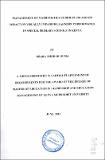| dc.description.abstract | Education is an essential pre-condition for economic and social development. Education enables individuals in their respective environments to recognize their potential for survival. Management is held to be the key factor in improving the standards of education bearing in mind a number of factors. Education improves family health, reduces infant mortality and changes reproductive behaviour. With education comes increased confidence and self-esteem. The Kenyan government has been stressing on the performance of science subjects where mathematics as a subject falls. The Special Needs Education is not left out in the education system and takes a larger share of the Ministry Of Education budget every year. Despite the government's commitment to providing free education for all school age children, however, education for the blind/Visually Impaired Learners' remain a drawback to realizing an ideal equality and universal primary education. Despite the govermnent's clear policies to free basic education for all school age children, research shows that visually impaired learners in Kenyan visually impaired special primary schools lag behind as far as mathematics performance is concerned. From the information sourced from the ministry of education offices of the Quality assurance and standards, the highest visually impaired scorer in mathematics in the year 2009 had 58% while the highest scorer from the regular schools had 98%. This information clearly points to the significant gap between the mathematics performance in regular school learners and the visually impaired learners in special primary schools. Minimal research has been carried out to find out the reasons behind the lag. This study therefore, investigated the management factors, social economic factors and school related factors contributing to the poor mathematics performance among the visually impaired learners in visually impaired special primary schools in Kenya. All the six special primary schools for the blind were sampled for the study. The population targeted was 396 respondents. Thus, 6 head teachers, 180 teachers and 210 learners. The data was collected through questionnaires for teachers, interview schedule for head teachers and focus group discussion for the learners. The collected data was analyzed both qualitatively, that is, thematically and quantitatively through frequency and percentage | en_US |

